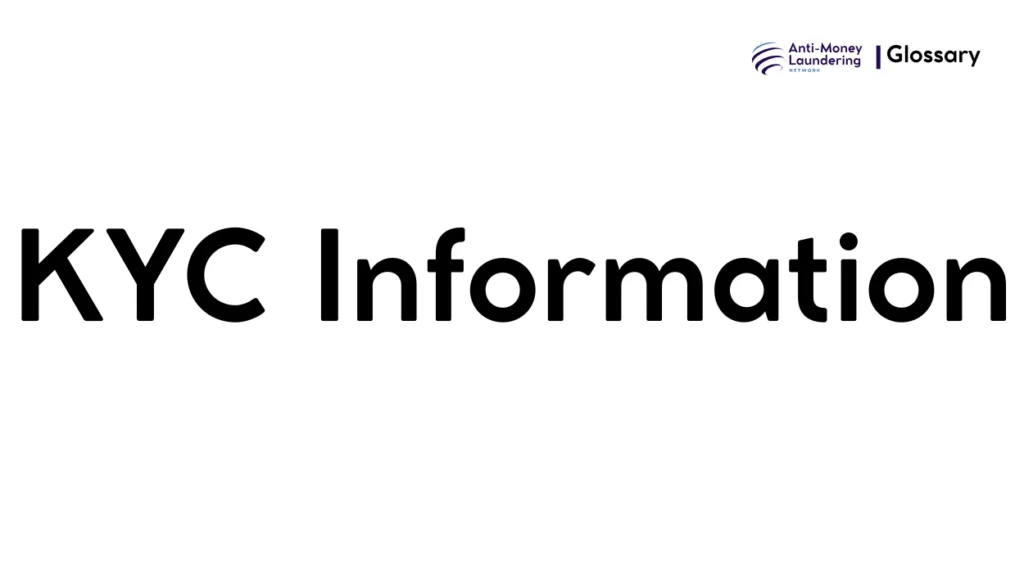Definition
KYC Information in Anti-Money Laundering (AML) refers to the critical data collected and verified by financial institutions and regulated entities about their customers. This process—”Know Your Customer” (KYC)—involves obtaining and confirming a customer’s identity, business activities, source of funds, and risk profile to prevent money laundering, terrorist financing, and other financial crimes.
Purpose and Regulatory Basis
KYC Information serves as a frontline defense in AML frameworks. It enables institutions to understand their customers’ identities and transaction behaviors, allowing early detection of suspicious or illicit activities. Globally, KYC is mandated by major AML regulations, including:
- Financial Action Task Force (FATF) Recommendations: Provide international standards for KYC and customer due diligence (CDD).
- USA PATRIOT Act: Requires U.S. financial institutions to implement customer identification programs (CIP).
- European Union Anti-Money Laundering Directives (AMLD): Set detailed KYC requirements across EU member states.
These regulations compel institutions to collect, verify, and continuously update KYC Information as a legal obligation to combat financial crime.
When and How it Applies
KYC Information is collected at various stages:
- Onboarding New Customers: Before establishing a business relationship, institutions must collect verified identity and relevant information.
- Periodic Reviews: KYC data is reviewed and updated based on risk assessment or after a certain period.
- Trigger Events: When suspicious activity is detected or there is a significant change in customer behavior or profile.
Examples: Opening a bank account, applying for a loan, engaging in wire transfers, or investing in financial products.
Types or Variants
KYC Information can be categorized into:
- Basic Identity Data: Name, date of birth, nationality, government-issued IDs.
- Verification Documents: Passports, driver’s licenses, utility bills as proof of address.
- Enhanced Due Diligence (EDD) Data: Required for high-risk customers, including source of wealth, business ownership details, and politically exposed person (PEP) status.
- Ongoing Monitoring Data: Transaction history, changes in customer information.
Procedures and Implementation
Institutions implement KYC through structured processes:
- Customer Identification Program (CIP): Collect and verify identity information.
- Customer Due Diligence (CDD): Assess risk level based on customer profile and transaction nature.
- Enhanced Due Diligence: For high-risk cases, deeper investigation and documentation.
- Record-Keeping: Secure storage of KYC data for prescribed timeframes.
- Continuous Monitoring: Automated systems flag unusual patterns.
- Training and Controls: Staff education and internal audits ensure adherence.
Technological tools, such as biometrics, AI-powered verification, and blockchain, increasingly support efficient KYC implementation.
Impact on Customers/Clients
From a customer perspective, KYC procedures mean:
- Providing personal and financial information upfront.
- Understanding that refusal or inability to provide satisfactory information can lead to service denial.
- Having limited privacy in financial dealings due to regulatory scrutiny.
- Benefiting from safer financial systems that deter fraud and financial crimes.
Duration, Review, and Resolution
KYC Information is:
- Collected at onboarding and reviewed periodically based on customer risk profile (e.g., annually for high-risk clients).
- Updated upon significant changes such as new address, change in ownership, or detected suspicious activity.
- Retained according to local regulatory mandates—often 5 to 10 years post-relationship termination.
Reporting and Compliance Duties
Institutions must:
- Maintain accurate KYC records.
- Report suspicious transactions or activities to appropriate authorities (e.g., Financial Intelligence Units).
- Demonstrate compliance in audits and regulatory inspections.
- Face penalties, including fines or license revocation, for KYC lapses.
Related AML Terms
KYC Information is closely linked with:
- Customer Due Diligence (CDD): The broader investigative process surrounding KYC.
- Enhanced Due Diligence (EDD): Deeper scrutiny for high-risk customers.
- Suspicious Activity Reports (SAR): Using KYC data to identify and report unusual transactions.
- Risk-Based Approach (RBA): Tailoring KYC efforts to risk levels.
Challenges and Best Practices
Common challenges include:
- Balancing thoroughness with customer convenience.
- Keeping up with evolving regulations.
- Preventing identity fraud and document forgery.
Best practices involve:
- Investing in advanced verification technology.
- Continuous staff training.
- Employing risk-based, flexible KYC models.
- Engaging in regular internal and external audits.
Recent Developments
Regulatory and technological trends impacting KYC Information include:
- Increased reliance on digital KYC methods, including biometric and AI-assisted identity verification.
- Regulatory moves toward harmonizing global standards and encouraging data sharing to reduce customer friction.
- Adoption of privacy-preserving technologies to protect customer data while ensuring compliance.
KYC Information is fundamental to AML compliance, empowering institutions to know their customers, manage risks, and prevent financial crimes. It is an evolving field shaped by regulatory demands and technological innovations, making it crucial for compliance officers and financial institutions to implement robust and adaptive KYC frameworks.

